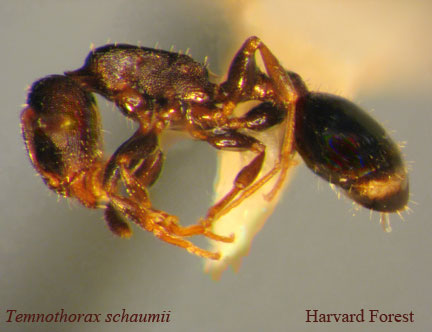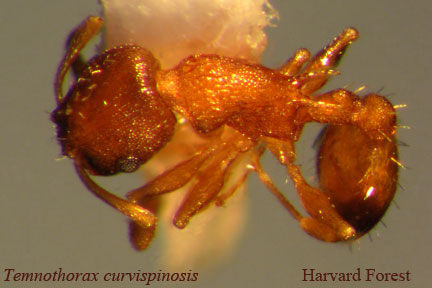Leptothorax
- Antennae normally 11-segmented
- Median carina absent from clypeus
- Tranverse crest present on stipes of maxilla
Temnothorax
- Antennae normally 12-segmented, but often 11-segmented in our region
- Median carina absent from clypeus
- Tranverse crest absent on stipes of maxilla
1a. Antennae with 12 segments; roughly sculptured with rugae on head, mesosoma, petiole, and post-petiole; gaster smooth and glossy; dark brown/black; *massive post-petiolar node, width ³ 1.5 × width of the petiole* T. texanus
1b. Antennae with 11 segments (may look like 12) 2
2a. Median carina present from clypeus (genus Temnothorax) 3
2b. Median carina present from clypeus (genus Temnothorax) 6
3a. Propodeal spines short, length < ½ the distance between their bases; normally dark brown; *head nearly covered with fine striae* T. schaumii
3b. Propodeal spines longer, color yellowish-brown to dark brown to black 4
4a. Dark brown to black ant; dorsum of head smooth, shining; propodeal spines long, pointing nearly straight backwards T. longispinosus
4b. Yellowish-brown ant; dorsum of head sculptured 5
5a. Propodeal spines well-separated at base; post-petiole notably broader than long T. ambiguus
5b. Propodeal spines close together at base; post-petiole subquadrate, not significantly broader than long T. curvispinosus
6 L. muscorum
Reference: Mackay, W. P. 2000. A review of the new world ants of the subgenus Myrafant, (genus Leptothorax) Hymenoptera: Formicidae. Sociobiology 36: 265-444.;
Discussions with Stefan Cover (MCZ), 11/15/2006
Temnothorax schaumii

Temnothorax curvispinosus
